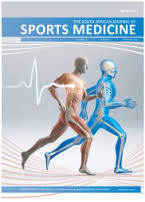A four-week home-based exercise programme is effective in treating subacute low back pain in adults
DOI:
https://doi.org/10.17159/2078-516X/2018/v30i1a5020Abstract
Background: Low back pain (LBP) is a prevalent condition affecting a large portion of the population world-wide and it is one of the leading causes of morbidity and work absenteeism.
Objective: To investigate the effectiveness of a four-week, home-based exercise program in treating subacute LBP in adults.
Methods: A quantitative, experimental research design was employed. Twenty male and female adults aged between 18 and 65 years with subacute LBP were recruited by means of advertisements and word of mouth and allocated into either a control group (CG) or a home-based exercise group (HG). Both groups underwent a pre-test that consisted of answering two questionnaires, the Visual Analogue Scale for Pain (VASP) and the Oswestry LBP and Disability Questionnaire. The (CG) received no intervention over the four-week intervention period, while the intervention group (HG) was given an exercise program and instructed to perform the exercises at home, three times a week for four weeks. After four weeks (post-test), the two questionnaires were repeated. After eight weeks (follow-up test) both groups again completed the two questionnaires. Descriptive statistics, non-parametric inferential statistics and Cohen’s effect size (d) were used to analyse the data and statistical significance was set at a confidence level of 95% (p?0.05).
Results: Following the home-based exercise intervention there were significant improvements observed in lower back pain and function for the HG. The HG’s Oswestry scores improved significantly (p=0.005) and their VASP also showed a significant improvement (p=0.011). Significant improvements also occurred between the pre-test and four-week follow-up for the HG’s Oswestry score (p=0.021) and for the HG’s VASP (p=0.005). No significant improvement was found for the CG between pre-test and post-test or between pre-test and the four-week follow-up. Large effect sizes (d>0.8) were also observed for the HG between the pre- and the post-test (d=1.59) as well as between the HG and the CG at post-test (d=1.52) and at the four-week follow-up (d=1.6).
Conclusion: The exercise intervention resulted in statistically significant and clinically significant improvements in both function and pain in adults with subacute LBP.
Downloads
Downloads
Published
Issue
Section
License
Copyright (c) 2018 South African Journal of Sports Medicine

This work is licensed under a Creative Commons Attribution 4.0 International License.
The South African Journal of Sports Medicine reserves copyright of the material published. The work is licensed under a Creative Commons Attribution 4.0 (CC BY 4.0) International License. Material submitted for publication in the South African Journal of Sports Medicine is accepted provided it has not been published elsewhere. The South African Journal of Sports Medicine does not hold itself responsible for statements made by the authors.
How to Cite
- Abstract 1227
- PDF 715






.png)